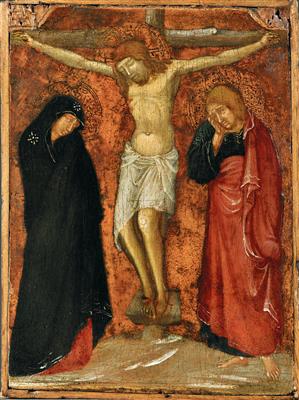Workshop of Pietro Lorenzetti

(Siena 1276–1348)
Crucifixion,
tempera on panel, 19.7 x 14.5 cm, unframed
Provenance:
sale, Sotheby’s London, 8 July 2004, lot 147 (as Sienese School, second half of the 14th Century);
with Salander-O’Reilly Galleries;
their sale, Christie’s New York, 9 June 2010, lot 203 (as Sienese School, second half of the 14th Century);
where acquired by the present owner
This devotional painting is of a highly refined quality and was most probably originally formed part of a small diptych. In the past this work has been assigned to the School of Duccio and to the Master of San Torpè from Pisa, it appears to be however, a new and important addition to the early corpus of works by Pietro Lorenzetti, and as such is a rare record of Sienese painting from the beginning of the Trecento.
The evident stylistic influence of Duccio is apparent and the archaic character of the figure drawing resembles that of Duecento painting in solemnity of form and the use of incised contours, as well as in the precious ornamentation of the nimbuses and the bordering of the robes. These qualities are accompanied by a marked sympathy of expression and a profoundly accented realism, reminiscent of Giotto, and typical of the earliest works of Pietro Lorenzetti.
The present work can be compared to Pietro Lorenzetti’s early
masterpieces of around 1315, including the frescoes in the left transept, and the mural triptych in the chapel of Saint John the Baptist, both in the Lower Basilica of San Francesco in Assisi (see C. Volpe, Pietro Lorenzetti ad Assisi, Milan 1965; C. Volpe, Pietro Lorenzetti, Milan 1989, pp. 22-29). The connection between this work and the great Sienese master’s first paintings on panel are also evident: the signed and dated Maestà in the Museo Diocesano di Cortona, the Monticchiello polyptych formed by the Madonna and Child in the Musée de Tessè, Le Mans, and the Saints in the Museo Horne, Florence, and above all the Crucifixion with Saint Francis and Saint Clare in the Fogg Art Museum, Massachusetts (see op. cit. Volpe, 1989, pp. 108-117).
The artist’s absolute stylistic identity is additionally evidenced by the figure types and the manner of painting, even in the minutest technical details of execution: this is also notable in another comparable altarpiece on a silver ground, representing the Madonna and Child enthroned with Saint Agnes and Saint Catherine conserved in the Museo Nazionale di Arte Medievale e Moderna, Arezzo, recognised as an early work of Pietro Lorenzetti by Federico Zeri (see P. Refice, in: Gubbio al tempo di Giotto, ed. by G. Benazzi/E. Lunghi/E. Neri Lusanna, exhibition catalogue, Gubbio 2018, p. 232-33).
Specialist: Mark MacDonnell
 Mark MacDonnell
Mark MacDonnell
+43 1 515 60 403
mark.macdonnell@dorotheum.at
10.11.2020 - 16:00
- Estimate:
-
EUR 150,000.- to EUR 200,000.-
Workshop of Pietro Lorenzetti
(Siena 1276–1348)
Crucifixion,
tempera on panel, 19.7 x 14.5 cm, unframed
Provenance:
sale, Sotheby’s London, 8 July 2004, lot 147 (as Sienese School, second half of the 14th Century);
with Salander-O’Reilly Galleries;
their sale, Christie’s New York, 9 June 2010, lot 203 (as Sienese School, second half of the 14th Century);
where acquired by the present owner
This devotional painting is of a highly refined quality and was most probably originally formed part of a small diptych. In the past this work has been assigned to the School of Duccio and to the Master of San Torpè from Pisa, it appears to be however, a new and important addition to the early corpus of works by Pietro Lorenzetti, and as such is a rare record of Sienese painting from the beginning of the Trecento.
The evident stylistic influence of Duccio is apparent and the archaic character of the figure drawing resembles that of Duecento painting in solemnity of form and the use of incised contours, as well as in the precious ornamentation of the nimbuses and the bordering of the robes. These qualities are accompanied by a marked sympathy of expression and a profoundly accented realism, reminiscent of Giotto, and typical of the earliest works of Pietro Lorenzetti.
The present work can be compared to Pietro Lorenzetti’s early
masterpieces of around 1315, including the frescoes in the left transept, and the mural triptych in the chapel of Saint John the Baptist, both in the Lower Basilica of San Francesco in Assisi (see C. Volpe, Pietro Lorenzetti ad Assisi, Milan 1965; C. Volpe, Pietro Lorenzetti, Milan 1989, pp. 22-29). The connection between this work and the great Sienese master’s first paintings on panel are also evident: the signed and dated Maestà in the Museo Diocesano di Cortona, the Monticchiello polyptych formed by the Madonna and Child in the Musée de Tessè, Le Mans, and the Saints in the Museo Horne, Florence, and above all the Crucifixion with Saint Francis and Saint Clare in the Fogg Art Museum, Massachusetts (see op. cit. Volpe, 1989, pp. 108-117).
The artist’s absolute stylistic identity is additionally evidenced by the figure types and the manner of painting, even in the minutest technical details of execution: this is also notable in another comparable altarpiece on a silver ground, representing the Madonna and Child enthroned with Saint Agnes and Saint Catherine conserved in the Museo Nazionale di Arte Medievale e Moderna, Arezzo, recognised as an early work of Pietro Lorenzetti by Federico Zeri (see P. Refice, in: Gubbio al tempo di Giotto, ed. by G. Benazzi/E. Lunghi/E. Neri Lusanna, exhibition catalogue, Gubbio 2018, p. 232-33).
Specialist: Mark MacDonnell
 Mark MacDonnell
Mark MacDonnell
+43 1 515 60 403
mark.macdonnell@dorotheum.at
|
Buyers hotline
Mon.-Fri.: 10.00am - 5.00pm
old.masters@dorotheum.at +43 1 515 60 403 |
| Auction: | Old Master Paintings |
| Auction type: | Saleroom auction with Live Bidding |
| Date: | 10.11.2020 - 16:00 |
| Location: | Vienna | Palais Dorotheum |
| Exhibition: | 04.11. - 10.11.2020 |
